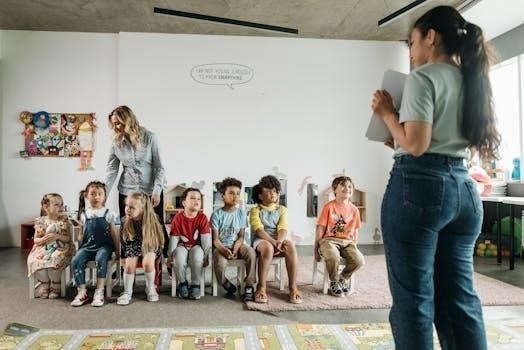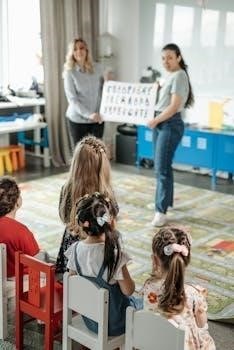Teaching Manual for Teachers⁚ A Comprehensive Guide
This comprehensive guide serves as an invaluable resource‚ offering structured materials and methodologies for effective teaching across various subjects. It aids educators in planning‚ delivering engaging lessons‚ and fostering student success‚ by developing key competencies and creating an environment of learning.
Teaching manuals are essential tools designed to support educators in their daily tasks. These manuals provide a structured collection of materials and methodologies‚ offering guidance on how to effectively teach specific subjects or courses. They aim to enhance the learning experience for students by equipping teachers with the necessary resources and strategies.
A well-crafted teaching manual can serve as a roadmap for teachers‚ outlining the objectives‚ content‚ and assessment methods for a particular curriculum. It helps teachers to organize their lessons‚ manage their classrooms‚ and evaluate student progress. By providing clear and concise instructions‚ teaching manuals ensure consistency and quality in teaching practices.
These manuals often include lesson plans‚ activities‚ assessments‚ and other resources that teachers can use to engage students and promote learning; They also offer insights into effective teaching techniques‚ such as differentiated instruction‚ cooperative learning‚ and technology integration. Ultimately‚ teaching manuals empower teachers to create a positive and productive learning environment.
Furthermore‚ teaching manuals are adaptable and can be modified to suit the needs of different classrooms and students. They encourage teachers to reflect on their teaching practices and make adjustments as needed. This iterative process of planning‚ teaching‚ and reflecting leads to continuous improvement and enhanced student outcomes.
Purpose and Importance of Teaching Manuals

The primary purpose of a teaching manual is to offer practical guidance and support to teachers‚ enabling them to deliver effective and engaging lessons. These manuals serve as comprehensive resources‚ providing structured materials‚ methodologies‚ and strategies that enhance the overall teaching and learning experience. By offering clear and concise instructions‚ teaching manuals promote consistency and quality in educational practices.
Teaching manuals play a vital role in streamlining lesson planning‚ classroom management‚ and assessment processes. They provide teachers with ready-to-use lesson plans‚ activities‚ and evaluation tools‚ saving valuable time and effort. This allows educators to focus more on student engagement and personalized instruction‚ fostering a positive and productive learning environment.
Moreover‚ teaching manuals promote professional development by introducing teachers to innovative teaching techniques and best practices. They encourage educators to reflect on their teaching methods and adapt their approaches to meet the diverse needs of their students. This continuous improvement cycle enhances teacher effectiveness and leads to better student outcomes.
In addition to supporting individual teachers‚ teaching manuals contribute to the overall coherence and alignment of curriculum across schools and districts. They ensure that all students receive a consistent and high-quality education‚ regardless of their location or background. This standardization is essential for promoting equity and excellence in education.
Key Components of an Effective Teaching Manual
An effective teaching manual comprises several key components that contribute to its overall usefulness and impact. Firstly‚ a clear and concise introduction outlining the manual’s purpose‚ scope‚ and intended audience is essential. This sets the stage for teachers to understand the manual’s relevance to their specific needs and context.
The core of the manual should consist of well-structured and detailed lesson plans. Each lesson plan should include clear learning objectives‚ engaging activities‚ assessment strategies‚ and differentiation techniques to cater to diverse learners. Practical examples and real-world applications should be integrated to enhance student understanding and engagement.
Classroom management strategies are another critical component of an effective teaching manual. The manual should offer practical tips and techniques for creating a positive and inclusive learning environment‚ managing student behavior‚ and promoting collaboration among students. These strategies should be evidence-based and aligned with best practices in education.
Assessment and evaluation methods should be clearly outlined in the manual. Teachers should be provided with a variety of assessment tools‚ such as quizzes‚ tests‚ projects‚ and rubrics‚ to effectively measure student learning and progress. Guidance on how to interpret assessment data and use it to inform instruction is also crucial.

Finally‚ an effective teaching manual should include resources and further reading materials to support teachers’ professional development. This may include links to relevant websites‚ articles‚ and books that provide additional information and insights on teaching strategies and best practices.
Curriculum Planning and Design
Curriculum planning and design are fundamental aspects of effective teaching. It involves the systematic process of defining learning goals‚ selecting appropriate content‚ and organizing instructional activities to facilitate student learning. Effective curriculum planning begins with a clear understanding of the desired learning outcomes. These outcomes should be aligned with national or state standards and reflect the knowledge‚ skills‚ and attitudes that students are expected to acquire.
Content selection is a critical step in curriculum design. Teachers must carefully choose content that is relevant‚ engaging‚ and aligned with the learning outcomes. The content should be age-appropriate and culturally sensitive‚ and it should provide students with opportunities to develop critical thinking‚ problem-solving‚ and communication skills.
Instructional activities should be designed to promote active learning and student engagement. Teachers should use a variety of teaching methods‚ such as lectures‚ discussions‚ group work‚ and hands-on activities‚ to cater to different learning styles and preferences. Technology can also be used to enhance the learning experience and provide students with access to a wider range of resources.
Assessment is an integral part of curriculum planning and design. Teachers should use a variety of assessment methods‚ such as formative and summative assessments‚ to monitor student progress and provide feedback. Assessment data should be used to inform instruction and make adjustments to the curriculum as needed.
Effective curriculum planning and design is an ongoing process. Teachers should regularly review and revise their curriculum to ensure that it remains relevant‚ engaging‚ and aligned with the needs of their students.
Effective Lesson Planning Strategies
Effective lesson planning is the cornerstone of successful teaching. It involves carefully designing each lesson to maximize student learning and engagement. A well-planned lesson ensures that learning objectives are clear‚ activities are purposeful‚ and assessment methods are aligned with the goals.
Begin by defining specific‚ measurable‚ achievable‚ relevant‚ and time-bound (SMART) learning objectives. These objectives should clearly state what students will be able to do by the end of the lesson. Align your activities and assessments directly with these objectives to ensure a focused and coherent learning experience.
Select engaging and varied activities that cater to different learning styles. Incorporate interactive elements such as group discussions‚ hands-on experiments‚ and multimedia presentations. This variety keeps students motivated and allows them to explore the material in different ways.
Structure your lesson with a clear beginning‚ middle‚ and end. Start with an engaging introduction to capture students’ attention and activate prior knowledge. The main body of the lesson should involve active learning and exploration of the topic. Conclude with a summary of key points and an assessment to check for understanding.

Incorporate assessment throughout the lesson to monitor student progress and adjust your teaching as needed. Use formative assessments such as quick quizzes‚ polls‚ and exit tickets to gauge understanding and provide immediate feedback.
Reflect on each lesson after it is taught to identify what worked well and what could be improved. Use this feedback to refine your lesson planning strategies and make your future lessons even more effective.
Classroom Management Techniques
Effective classroom management is crucial for creating a positive and productive learning environment. It involves establishing clear expectations‚ fostering a sense of community‚ and addressing disruptive behavior promptly and fairly. A well-managed classroom allows teachers to focus on instruction and students to learn effectively.
Establish clear rules and expectations from the beginning of the school year. Involve students in creating these rules to foster a sense of ownership and responsibility. Make sure the rules are communicated clearly and consistently enforced.
Build positive relationships with your students by showing genuine interest in their lives and creating a supportive and inclusive classroom culture. Get to know your students’ interests‚ strengths‚ and challenges.
Use positive reinforcement to encourage desired behaviors. Praise students for their efforts‚ celebrate their successes‚ and provide positive feedback regularly. Focus on what students are doing well rather than dwelling on their mistakes.
Address disruptive behavior promptly and fairly. Have a clear system for dealing with misbehavior‚ such as verbal warnings‚ time-outs‚ or parent-teacher conferences. Be consistent in your application of consequences.
Use nonverbal cues to manage student behavior. A simple look‚ gesture‚ or proximity can often be enough to redirect a student who is off-task.
Create a classroom environment that is conducive to learning. Organize the physical space to minimize distractions and maximize student engagement. Ensure that students have access to the materials and resources they need.
Assessment and Evaluation Methods
Assessment and evaluation are integral components of the teaching and learning process. They provide valuable insights into student understanding‚ inform instructional decisions‚ and measure the effectiveness of teaching strategies. A variety of assessment methods should be used to gain a comprehensive understanding of student learning.
Formative assessment is ongoing and provides feedback to both teachers and students throughout the learning process. Examples include quizzes‚ class discussions‚ and exit tickets. This helps guide instruction and allows for adjustments to teaching strategies.
Summative assessment is used to evaluate student learning at the end of a unit or course. Examples include exams‚ projects‚ and presentations. These assessments measure overall understanding and mastery of content.
Diagnostic assessment is used to identify students’ strengths and weaknesses before instruction begins. This helps teachers tailor instruction to meet the individual needs of their students.
Authentic assessment requires students to apply their knowledge and skills to real-world situations. Examples include simulations‚ case studies‚ and performance tasks. These assessments demonstrate practical application.
Rubrics are scoring guides that provide clear criteria for evaluating student work. They help ensure that assessment is fair‚ consistent‚ and objective.
Portfolios are collections of student work that demonstrate their learning progress over time. They provide a comprehensive view of student growth and achievement.
Utilizing Technology in the Classroom
Technology offers a multitude of opportunities to enhance teaching and learning‚ making lessons more engaging‚ interactive‚ and accessible. Integrating technology effectively requires careful planning and consideration of pedagogical goals.
Interactive whiteboards can transform traditional lectures into dynamic learning experiences. Teachers can use them to display multimedia content‚ annotate documents‚ and facilitate collaborative activities.
Online learning platforms provide access to a vast array of educational resources‚ including videos‚ simulations‚ and interactive exercises. They also enable personalized learning and track student progress.
Educational apps and software can make learning more fun and engaging. There are apps for virtually every subject‚ from math and science to language arts and history.
Digital tools can support student collaboration and communication. Students can use online forums‚ shared documents‚ and video conferencing to work together on projects and assignments.
Assistive technology can help students with disabilities access the curriculum and participate fully in classroom activities. Examples include screen readers‚ text-to-speech software‚ and alternative input devices.
It is important to teach students how to use technology responsibly and ethically. This includes addressing issues such as digital citizenship‚ online safety‚ and copyright.
Technology should be used to enhance teaching and learning‚ not to replace it. Teachers should carefully consider how technology can best support their instructional goals and student needs.
Fostering Inclusive Education Practices
Inclusive education is the practice of educating all students‚ regardless of their abilities‚ disabilities‚ or backgrounds‚ in the same classroom. It is based on the belief that all students have the right to learn and participate in the educational community.
Creating an inclusive classroom requires a shift in mindset and a commitment to meeting the diverse needs of all students. Teachers must be willing to adapt their teaching methods‚ materials‚ and assessments to accommodate individual learning styles and needs.
Differentiated instruction is a key strategy for inclusive education. It involves tailoring instruction to meet the specific needs of each student. This may include providing different levels of support‚ using varied instructional materials‚ and offering a range of assessment options.
Collaboration is essential for inclusive education. Teachers‚ parents‚ and other professionals must work together to develop and implement individualized education programs (IEPs) for students with disabilities.
Creating a welcoming and supportive classroom environment is crucial for fostering inclusive education. Students should feel safe‚ respected‚ and valued for their unique contributions.
Universal Design for Learning (UDL) is a framework for designing instruction that is accessible to all students. UDL principles include providing multiple means of representation‚ action and expression‚ and engagement.
Assistive technology can play a significant role in inclusive education. It can help students with disabilities access the curriculum‚ participate in classroom activities‚ and demonstrate their learning.
Ongoing professional development is essential for teachers to stay up-to-date on best practices in inclusive education.
Professional Development and Growth for Teachers
Continuous professional development is paramount for teachers to remain effective and adaptable in the ever-evolving educational landscape. It encompasses a range of activities that enhance knowledge‚ skills‚ and pedagogical approaches.
Attending workshops‚ conferences‚ and seminars provides opportunities to learn about new research‚ teaching strategies‚ and technologies. These events also foster networking and collaboration with fellow educators.
Engaging in action research allows teachers to investigate their own practices and identify areas for improvement. This reflective process promotes self-awareness and data-driven decision-making.
Pursuing advanced degrees or certifications demonstrates a commitment to lifelong learning and expertise in a specific subject area or educational field.
Participating in peer observation and mentoring programs provides valuable feedback and support from colleagues. This collaborative approach fosters a culture of shared learning and growth.
Utilizing online resources‚ such as webinars‚ articles‚ and professional learning communities‚ offers convenient and accessible opportunities for professional development.
Seeking out leadership roles‚ such as department head or curriculum coordinator‚ allows teachers to develop their leadership skills and contribute to school-wide improvement efforts.
Reflecting on teaching practices‚ seeking feedback from students and parents‚ and staying abreast of current educational trends are essential for continuous professional growth.
Professional development should be aligned with individual needs‚ school goals‚ and district initiatives to maximize its impact.
Collaboration and Communication with Parents and Stakeholders
Effective collaboration and communication with parents and stakeholders are vital for student success and a positive school environment. Open and transparent communication channels foster trust and mutual understanding.
Regular parent-teacher conferences provide opportunities to discuss student progress‚ address concerns‚ and develop strategies for supporting learning at home. These meetings should be collaborative and solution-oriented.
Utilizing various communication tools‚ such as email‚ newsletters‚ and online platforms‚ keeps parents informed about classroom activities‚ assignments‚ and school events. Timely and relevant information enhances parental involvement.
Creating a welcoming and inclusive classroom environment encourages parents to participate in school activities and volunteer their time. Parental involvement enriches the learning experience for all students.
Establishing a school-community partnership fosters collaboration between the school and local organizations. This partnership provides access to resources and support services that benefit students and families.
Actively seeking feedback from parents and stakeholders through surveys and focus groups helps to identify areas for improvement and address community concerns. This feedback informs school policies and practices.
Communicating student achievements and successes to parents and stakeholders reinforces positive relationships and celebrates student growth. Positive communication builds morale and strengthens community support.
Addressing conflicts and concerns promptly and respectfully prevents escalation and maintains positive relationships. Clear communication and active listening are essential for resolving disputes.
Promoting cultural sensitivity and understanding in communication practices ensures that all parents and stakeholders feel valued and respected.
Resources and Further Reading for Teachers
To support continuous professional growth‚ teachers need access to a variety of resources and opportunities for further reading. These resources can enhance teaching skills‚ deepen subject matter knowledge‚ and promote innovative classroom practices.
Professional journals and educational websites offer valuable insights into current research‚ best practices‚ and emerging trends in education. Staying informed about the latest developments is crucial for effective teaching.
Teacher resource books and manuals provide practical strategies‚ lesson plans‚ and assessment tools that teachers can adapt and implement in their classrooms. These resources save time and enhance instructional quality.
Online learning platforms and webinars offer convenient and flexible opportunities for teachers to engage in professional development activities. These platforms provide access to expert-led courses and interactive learning experiences.
Professional organizations and associations provide networking opportunities‚ conferences‚ and workshops that connect teachers with colleagues and experts in their field. These connections foster collaboration and knowledge sharing.
University courses and graduate programs offer advanced training and specialization in various areas of education. Pursuing higher education can enhance teaching expertise and career advancement opportunities.
Mentoring programs and peer coaching provide support and guidance from experienced teachers. These programs foster collaboration and promote reflective practice.
Educational blogs and online communities offer platforms for teachers to share ideas‚ ask questions‚ and collaborate on projects. These communities foster a sense of belonging and provide ongoing support.

Access to technology and digital resources enhances teaching and learning by providing engaging and interactive learning experiences.